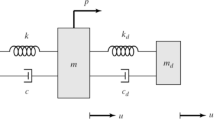Abstract
The mean interference effects between two rectangular buildings located in close proximity in a geometrical configuration of ‘L’ and ‘T’ plan shape are studied through wind tunnel test on 1:300 scale rigid models. The mean surface pressure distributions on all the walls of two buildings located in close proximity as well as in an isolated position are measured over an extended range of wind directions. The mean responses of pair of buildings namely, block-1 and block-2 subjected to interference effects are evaluated using experimentally obtained wind loads and, subsequently compared it, with the responses of a similar building in an isolated position. Effectiveness of upstream building location and wind orientation in changing the mean wind pressure distributions and responses of upstream and downstream building are also assessed. At wind incidence angle of 0°, presence of upstream block-1 reduces the mean along-wind displacement of block-2 of ‘L’ and ‘T’ shape arrangements up to 25% and 71% respectively as compared to that of corresponding block in an isolated position. However, the presence of upstream block-1 increases the maximum mean torque on block-2 of ‘L’ and ‘T’ shape arrangement up to 28%, and up to 88% respectively as compared to maximum mean torque developed on a similar block in an isolated position.
Similar content being viewed by others
References
Ahuja, A. K., Pathak, S. K., and Mir, S. A. (1991). “Interference effect on wind loads on tall buildings.” Evaluation and Rehabilitation of Concrete Structures and Innovations in Design-Proc, ACI Int. Conf., Hongkong, SP-128, Vol. 2, pp. 973–986.
ASCE: 7-02, (2002). “Minimum design loads for buildings and other structures.” American Society of Civil Engineers, Reston, Virginia.
ASCE: 7-98 (1998). “Minimum design loads for buildings and other structures.” American Society of Civil Engineers, Reston, Virginia.
Boggs, D. W., Hosoya, N., and Cochran, L. (2000), “Sources of torsional wind loading on tall buildings: Lessons from the wind tunnel.” Proc. 2000 Structures Congress & Expositions, SEI/ASCE, Philadelphia, pp. 1–8.
English, E. C. (1993). “Shielding factors for paired rectangular prisms: an analysis of alongwind mean response data from several sources.” Proc. 7 th US National Conf. on Wind Engg., University of California, Los Angeles, CA, pp. 193–201.
English, E. C. and Fricke, F. R. (1999). “The interference index and its prediction using a neural network analysis of wind-tunnel data.” Journal of Wind Engineering and Industrial Aerodynamics, Vol. 83, Nos. 1–3, pp. 567–575.
Eurocode-1 (1995). Actions on structures — General actions — Part 1–4: wind actions, ENV 1991-1-4.
Harris, C. L. (1934). “Influence of neighboring structure on wind pressure on tall building.” Bureau of Standards, J. Res., Vol. 12, pp. 103–118.
IS: 875 (1987). Code of practice for the design loads (other than earthquake) for buildings and structures, Part-3, (wind loads), New Delhi, India.
Kato, Y. and Nishikawa, K. (2002). “On aerodynamic interference between two motorcycles.” Transaction of Society of Automotive Engineers of Japan, Vol. 33, No. 4, pp. 139–144.
Kelnhofer, W. J. (1971). “Influence of neighbouring building on flat roof wind loading.” Proc. 3 rd International conference on Wind Effects on Buildings and Structures, Tokyo, Japan, pp. 221–230.
Khanduri, A. C., Bedard, C., and Stathopoulos, T. (1997). “Modelling wind-induced interference effects using back propagation neural networks.” Journal of Wind Engineering and Industrial Aerodynamics, Vol. 72, pp. 71–79.
Khanduri, A. C., Stathopoulos, T., and Bedard, C. (1998). “Windinduced interference effects on buildings — a review of the state-of-the-art.” Engineering Structures, Vol. 20, No. 7, pp. 617–630.
Khanduri, A. C., Stathopoulos, T., and Bedard, C. (2000). “Generalization of wind-induced interference effects for two buildings.” Wind and Structures, An International Journal, Vol. 3, No. 4, pp. 255–266.
Kwok, K. C. S. (1995). “Aerodynamics of tall buildings — a state of the art in wind engineering.” Proc. 9 th International Conference on Wind Engineering, New Delhi, India, pp. 180–204.
Melbourne, W. H. and Sharp, D. B. (1976). “Effects of upwind buildings on the response of tall buildings.” Proc. Regional Conference on Tall Buildings, Hong Kong, pp. 174–191.
Sakamoto, H. and Haniu, H. (1988). “Aerodynamic forces acting on two square prisms placed vertically in a turbulent boundary layer.” Journal of Wind Engineering and Industrial Aerodynamics, Vol. 31, No. 1, pp. 41–66.
Saunders, J. W. and Melbourne, W. H. (1979). “Buffeting effects of upwind buildings.” Proc. 5 th International Conference on Wind Engineering, Fort Collins, pp. 593–605.
Tang, U. F. and Kwok, K. C. S. (2004) “Interference excitation mechanisms on a 3 DOF aeroelstics CAARC building model.” Journal of Wind Engineering and Industrial Aerodynamics, Vol. 92, Nos. 14–15, pp. 1299–1314.
Taniike, Y. (1992). “Interference mechanism for enhanced wind forces on neighboring tall buildings.” Journal of Wind Engineering and Industrial Aerodynamics, Vol. 42, Nos. 1–3, pp.1073–1083.
Xie, Z. N. and Gu, M. (2004). “Mean interference effects among tall buildings.” Engineering Structure, Vol. 26, No. 9, pp. 1173–1183.
Zhang Z., Ying, C. Z., and Jie, L. (2010). “Vehicles aerodynamics while crossing each other on road based on computational fluid dynamics.” Applied Mechanics and Materials, Vol. 29–32, pp. 1344–1349.
Author information
Authors and Affiliations
Corresponding author
Rights and permissions
About this article
Cite this article
Amin, J.A., Ahuja, A. Wind-induced mean interference effects between two closed spaced buildings. KSCE J Civ Eng 16, 119–131 (2012). https://doi.org/10.1007/s12205-012-1163-y
Received:
Revised:
Accepted:
Published:
Issue Date:
DOI: https://doi.org/10.1007/s12205-012-1163-y




